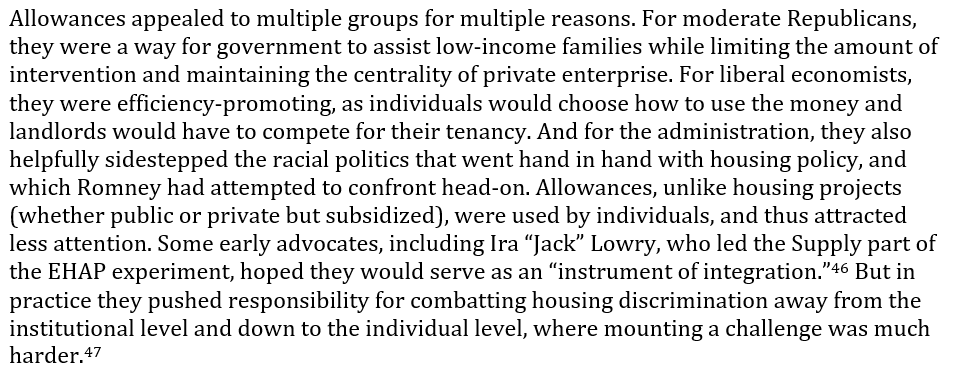I cut 3000 words on the rise of economics in U.S. housing policy this week. In tribute (and since blogs are dead), I turned it into a very long Twitter thread. 1/
This was part of a mega-chapter on how liberal economists helped rein in the Great Society – though they supported many of its goals – then found a surprising ally in Nixon. 2/
In housing, the impact of economics lagged a bit relative to, say, antipoverty policy – though in the end the story’s the same. 3/
Like other social policy domains, RAND and its Planning-Programming-Budgeting System (PPBS) were key to its introduction. 4/
RAND actually made a pitch to house the new Urban Institute that was being created to support the research needs of the new Department of Housing and Urban Development. 5/
Urban became its own entity instead, but was led by William Gorham, economist, onetime RAND analyst, and implementer of PPBS at the Department of Health, Education and Welfare. 6/
It might have seemed like HUD was well-positioned to draw on economic expertise from its 1965 creation, since Secretary Robert C. Weaver, the first Black cabinet member, was also a Harvard economics PhD (and first there as well). 7/
But Weaver was alienated from the economics profession, and his first commitment was to the fight for civil rights. Unlike OEO or HEW, HUD established no strong economic analysis office. (From a 1944 interview quoted in Wendell Pritchett’s wonderful 2008 biography.) 8/
Instead, engineers became the most influential early experts at HUD – a trend reinforced by Nixon’s next secretary, George Romney, under whom a literal rocket scientist led the Office of Research and Technology. 9/
Romney, with his auto industry background, hoped the engineers would advance the construction of cheap factory-produced housing. But he, too, sought to use HUD to promote desegregation – a commitment that landed him in trouble with President Nixon. 10/
While Nixon was increasingly opposed to federal efforts to desegregate, he nevertheless saw himself as a “conservative domestic innovator”, in Jeremy Johnson’s phrase. 11/ https://www.jstor.org/stable/pdf/90017494.pdf">https://www.jstor.org/stable/pd...
And as hopes for passage of his Family Assistance Plan – the closest this nation has ever come to guaranteed income – faded, Nixon became increasingly enamored of housing vouchers as a way to help the needy without government ownership or complex programs. 12/
Vouchers – then called housing allowances, and before that rent supplements or certificates – were not a new idea. The idea had been floated as early as the 1930s, and even public housing advocates like Weaver were willing to consider the possibility. 13/
By 1969, they had picked up champions in the form of two Massachusetts Republicans – including Black senator Edward Brooke, who inserted an experimental housing allowance program into the 1970 Housing and Urban Development Act. 14/ https://washingtonmonthly.com/2016/06/30/the-monthly-interview-the-man-who-reinvented-public-housing/">https://washingtonmonthly.com/2016/06/3...
You may be wondering what any of this has to do with economists. Well, the 1960s was also seeing the emergence of urban and housing economics subfields (which @undercoverhist, now sadly gone from Twitter, is working on). 15/
In addition to the work being done at RAND and Urban, Resources for the Future (with support from – who else – the Ford Foundation) helped nurture an intellectual community and support urban economics specializations in doctoral programs. 16/
And economists tended to like the idea of housing vouchers, for the same reason they favored a negative income tax: efficiency. 17/
Nixon’s new HUD sec& #39;y, James Lynn, stopped relying on Romney’s engineers and created an Office of Policy Development & Research, led by economist Michael H. Moskow. Economic analysis became increasingly important at HUD, & by 1975 PD&R had a budget of $67m and a staff of 125. 18/
The Experimental Housing Allowance Program, too, became increasingly well-funded. Led by the usual suspects at Urban, RAND, SRI and Abt Associates, it ultimately cost $175m – three-quarters of a billion today. 19/ https://escholarship.org/uc/item/2rq1v2r1">https://escholarship.org/uc/item/2...
It “was the largest in number of participants, longest in duration, most expensive, and operationally most complex” of the era’s social policy experiments, and trained a generation of researchers on housing policy. 20/ https://www.rand.org/pubs/papers/P6785.html">https://www.rand.org/pubs/pape...
And while Nixon did not see housing vouchers expanded, Congress created Section 8 – a housing voucher program – in the first days of Ford. Policy shifted from the supply side (public housing + builder subsidy) to demand side (individual rent assistance). 21/
As in other social policy domains, housing was a place where Great Society government expansion unintentionally led to increased use of economics in policy – which in turn became a means to rein in some of the original impulses behind that expansion. 23/
And while this bit of the story ends in 1974, the fundamental shift – toward responding to housing problems by subsidizing individual choice – remains visible today. /fin https://www.vox.com/future-perfect/2019/8/4/20726427/raj-chetty-segregation-moving-opportunity-seattle-experiment">https://www.vox.com/future-pe...
https://www.votwitter.com/future-perfect/2019/8/4/20726427/raj-chetty-segregation-moving-opportunity-seattle-experiment

 Read on Twitter
Read on Twitter





